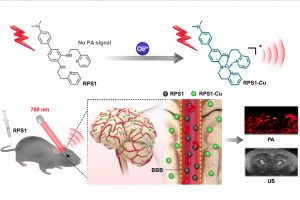A research team from the Faculty of Health Sciences (FHS) of the University of Macau (UM) has developed a brain imaging tool for patients with Alzheimer’s disease (AD). It is a new technology for photoacoustic (PA) imaging of Copper (II) in the brains of patients with AD. The study has been published in Angew. Chem. Int. Ed. and was highlighted in ChemistryViews.
Copper is the third most abundant trace metal in the human body and plays a vital role in the various physiological and pathological activities. Copper (II) enrichment in the brain is highly related to AD pathogenesis. Therefore, highly sensitive imaging and detection of Copper (II) in the brains of patients suffering from AD is essential to a comprehensive understanding of the pathological events that occur in the brain. However, in vivo fluorescence imaging of Copper (II) in the brain still presents an enormous challenge because of limited penetration depth, the difficulty for probes to cross the blood-brain barrier (BBB), and the fluorescence quenching resulting from the paramagnetic effect of Copper (II).
PA imaging combines optical imaging and ultrasound imaging into a hybrid modality, in which biological tissue (or probes) absorbs laser pulses and emit ultrasonic waves that are easy to detect. The current design strategy for PA probes is mainly based on extending the molecular -conjugation to enhance the signal and shift the wavelength to near-infrared (NIR) region. Unfortunately, this in turn increases the molecular size and thus makes the probe difficult to cross BBB.
To address this challenge, the research team led by Assistant Professor Zhang Xuanjun from the FHS developed a series of activatable photoacoustic (PA) probes with low molecular weights (<440 Da), which can specifically chelate with Copper (II) to form radicals with turn-on PA signals in the NIR region. They applied these probes for brain imaging in collaboration with Sheng Zonghai, a researcher from the Shenzhen Institute of Advanced Technology (CAS), Zhang Jingjing, a professor at the Affiliated Hospital of Guangdong Medical University, and Yuan Zhen, a professor in the FHS at UM.
In the study, the probes effectively crossed BBB and allowed the researchers to visualise, for the first time, Copper (II) in a mouse brain via the PA technique. The study has also verified that the level of Copper (II) is much higher in a brain with AD than in a normal brain. These small-molecule probes are expected to find applications in AD diagnosis, drug screening, and treatment evaluation. More information about the study can be found at https://doi.org/10.1002/anie.201904047. For highlights in ChemistryViews please visit https://www.chemistryviews.org/details/ezine/11175574/Sounding_Out_Alzheimers_Disease.html.
Source: Faculty of Health Sciences
Media Contact Information:Communications Office, University of Macau
Albee Lei Tel:(853) 88228004Kelvin U Tel:(853) 88224322Email:prs.media@um.edu.moUM Website:www.um.edu.mo


